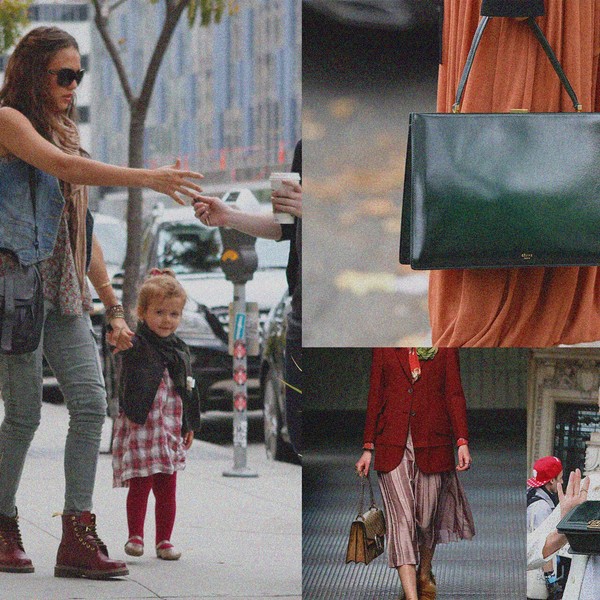‘Wall Talk’ with Australian Muralist George Rose
Discussing flora, fauna, turf wars, and spiders with the prolific painter.
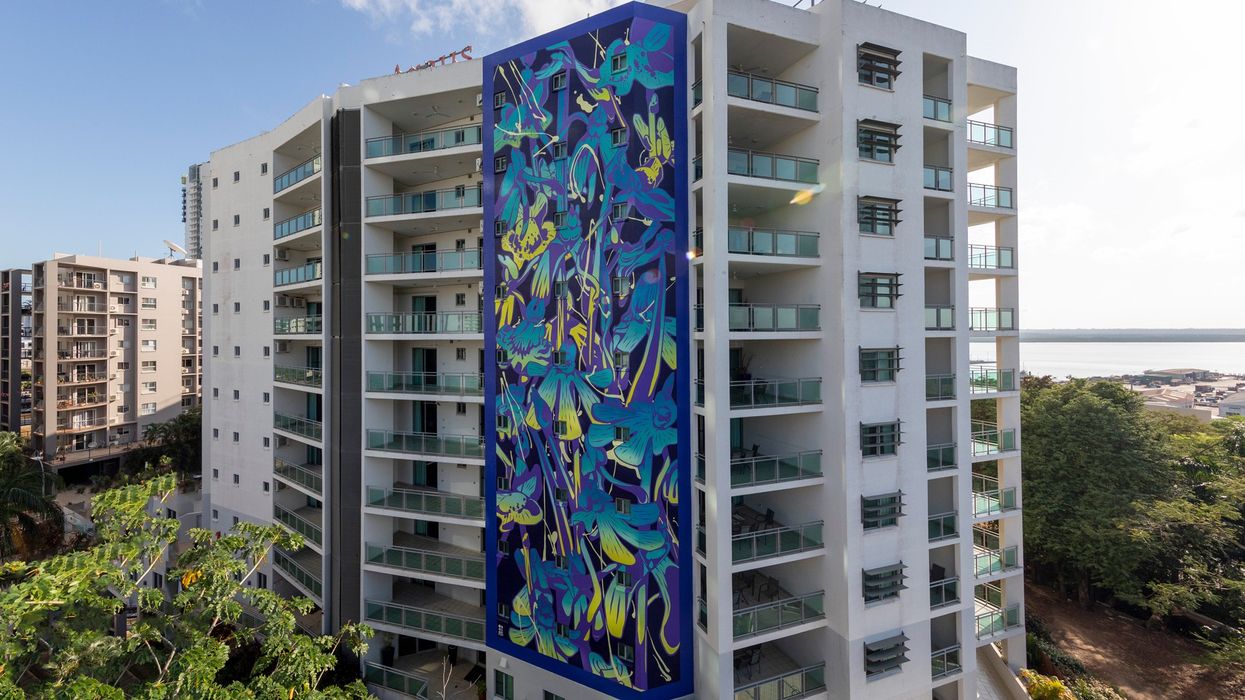
George Rose, a muralist known for her vibrantly-colored murals of flowers, assures me her name has no connection to her chosen subject matter. “My dad’s a forester, so he’d always take us out to the bush," she explains. "Because I was surrounded by nature, I developed that interest in flowers. I can’t control my name, but it’s a nice synergy.” At 10 years old, Rose found herself at a crossroads—pursuing her dream of becoming an astronaut or following her artistic ambitions. Her parents made the prescient decision to nudge her toward art—one small step for Rose, one giant leap for the niche muralist community of Australia.
After studying art and graphic design in school, Rose was an artistic jack-of-all-trades shifting between murals, festival set dressing, and sign painting, among other channels. Stifled by the commercialism of sign writing, she narrowed her interests to the medium she found most fulfilling: ”Painting big walls.” After 10 years growing her practice and painting murals internationally, Rose’s work has a distinct visual signature: boldly illustrative florals and botanicals, contrasting vibrant colors, and spray-painted fades. Speaking to her shortly after completing a whopping seven-foot mural, I talked to Rose about sources of inspiration, the physical toll of painting murals, and where she wants to take her creative practice next.

Yoshi Yanagita
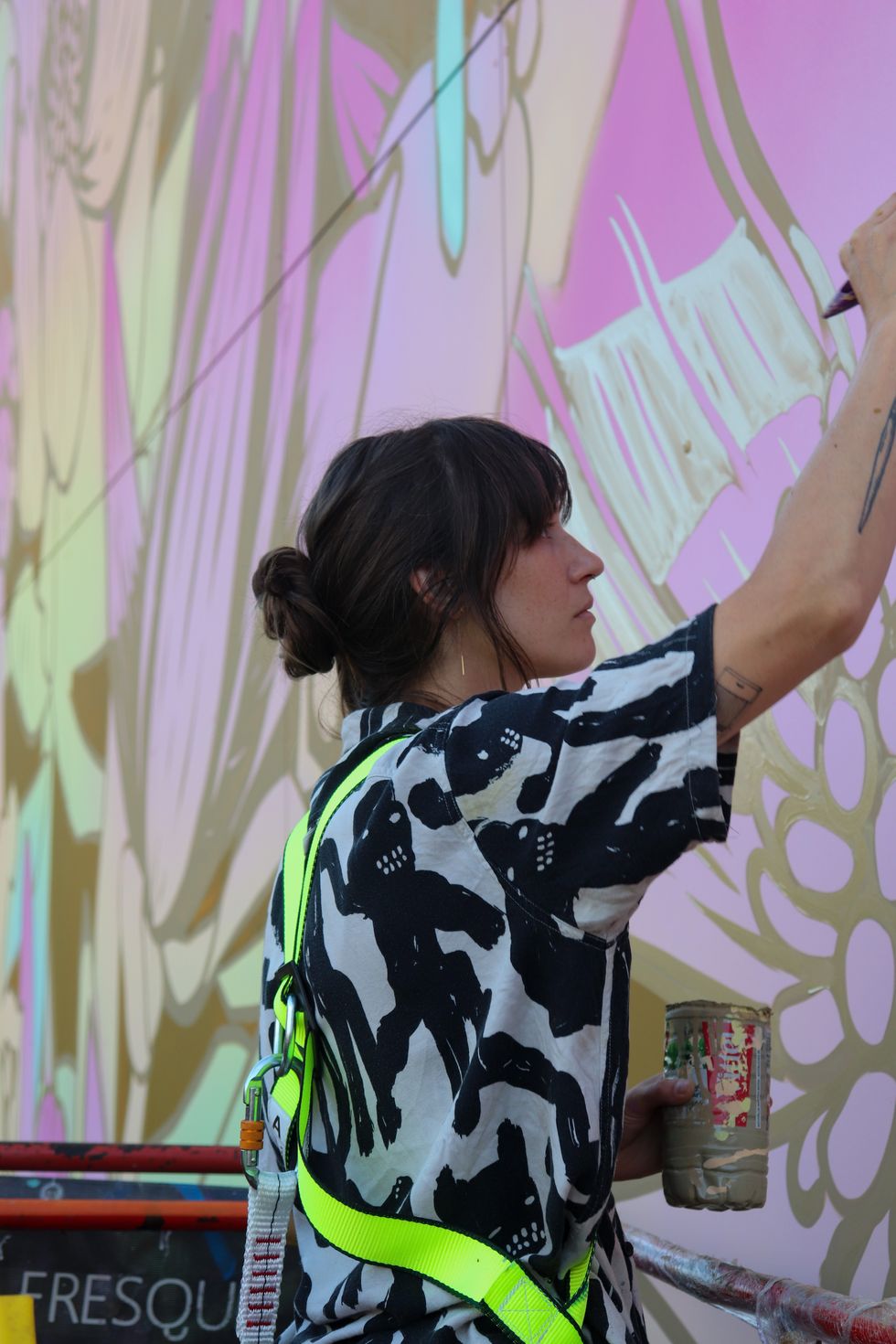
Joel Colin
Coveteur: What initially got you interested in painting?
George Rose: “My mom was a teacher and used to work with really difficult students. She used to do a lot of sports and arts & crafts with them. When my parents had kids they just continued that, and I grew up always creating, painting, and drawing.
As a teenager, I started taking notice of street art and murals, and I became a bit obsessed with them. I wanted to paint on the streets. At that time, it was only men. In my generation of artists, there were a few women with similar experiences growing up and thinking, ‘Why is it only dudes doing this?’ And then we decided, ‘I can do that. That’s easy.’ So we just started painting on the streets.
So, it was something that I just started doing. One thing led to another, and more jobs came in. Before I focused primarily on murals, I was doing ceramics, lighting installations, oil painting, digital illustration, festival set dressing, and sign writing. It was too crazy. At some point, I met someone I used to work with, and he said, ‘If you could choose one thing, what would it be?’ And I said, ‘Paint big walls.’ He said, ‘Great, just do that.’ From there, I was like, ‘Okay, cool. I paint big walls now.’ That’s how it all happened.”
Between the graffiti artists, muralists, and sign artists, is there ever beef amongst the communities?
GR: “So writers [graffiti artists]—the hardcore bombers and tags—really dislike muralists. Then sign writers who paint advertisements get mixed up with muralists, and it’s like, ‘No, no, this is paid advertising that they’re painting. This isn’t art.’ I wouldn’t say there’s animosity, but people want to define who they are and what they stand for.”
There are only so many walls, so I imagine it can get really territorial.
GR: “I’ve got friends who have painted over pieces and then been targeted for it. Crews will go after their particular work, and it’ll go back and forth. I try to stay out of it because I’m not a super aggressive or competitive person. I’m way more like, ‘Everybody be friends!’”
Yeah, that sounds like beef you don’t want to get mixed up in.
GR: “That’s why I like doing the bigger walls. Doing seven stories or above—who cares about the bottom layer?”
That must be so physically taxing doing work on such a large scale. How do you prepare for a seven-story project?
GR: “You slowly build up to it over time. The first one I did was one story, and I was like, ‘This is huge!’ Then I did a two-story, then three, then five—you slowly get bigger and bigger and, eventually, it feels normal. I never really think about it being large or overwhelming anymore. But it is super physical, so it’s like training for a sport. When you stop painting for a period of time, it’s easy to get injured, so you have to keep training for it.”
What are the challenges of working on this scale? I imagine it’s hard to take a step back and take in the entire work when they are so large.
GR: “I find it hard to paint very small now [laughs]. There’s a kind of beauty in what I do in that it’s not directly re-creating something that already exists. I’m not replicating a photo. I’m creating something that corresponds to the wall itself. So I’ve got a design and discussed it with the client, but I also make decisions on the wall itself. It’s important for people to understand that this art is responsive and alive—it changes.”
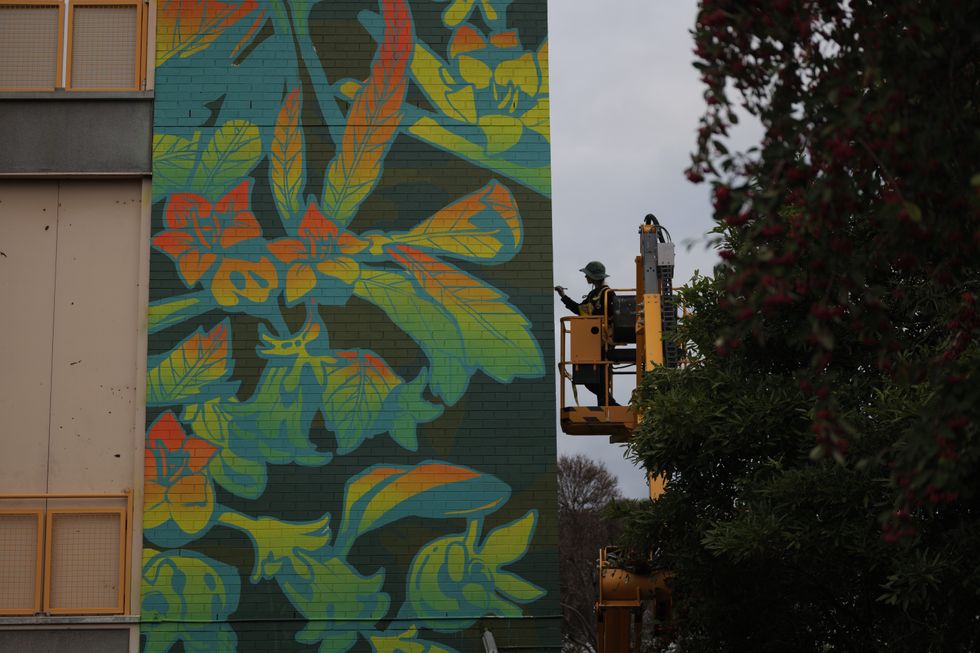
Yoshi Yanagita
Are there mural scenes in other cities that you really like?
GR: “There’s a really strong Spanish style—I haven’t seen it in person yet, but I’d love to go to Spain. There’s a specific American style like in LA. I got picked up a lot more in the States than I did in Europe. My style resonates with California and also Michigan for some reason.”
You use a lot of natural and floral motifs—what kind of symbolism do you weave into your work?
GR: “I like to look into endemic flora. I research the locations of the murals and find endangered flora or at least species endemic to the places, so there is a link to the area’s identity. I hope it brings more awareness to the plight of these flowers or botanicals in these areas. I’ve also been collecting photos and images of flowers from everywhere I go and incorporating more of that imagery in new places. It’s almost a process of pollination, taking these images from one location and planting them somewhere else. Also, you can’t really get away from the concept of femininity or sexuality with plants—they’re literally sexual organs.
“There’s always an element of identity in the work. Because this line of work can be quite masculine, but the colors and motifs are quite feminine, there is a juxtaposition in the work itself.”
Do you have a favorite flower?
GR: “I do! It’s the kangaroo paw. [Shows a tattoo] I’ve got one on the back [of my arm]—there are flowers for all my family. My mom likes lilies, my dad loves rosewood, and then there’s a kangaroo paw over there [pointing to her tattoo].”
Did you draw those yourself for the tattoo artist?
GR: “For a while, I drew my tattoos, but I got to a point where I was like, ‘I can’t draw everything that I love.’ I am much happier to let the artists do their thing.”
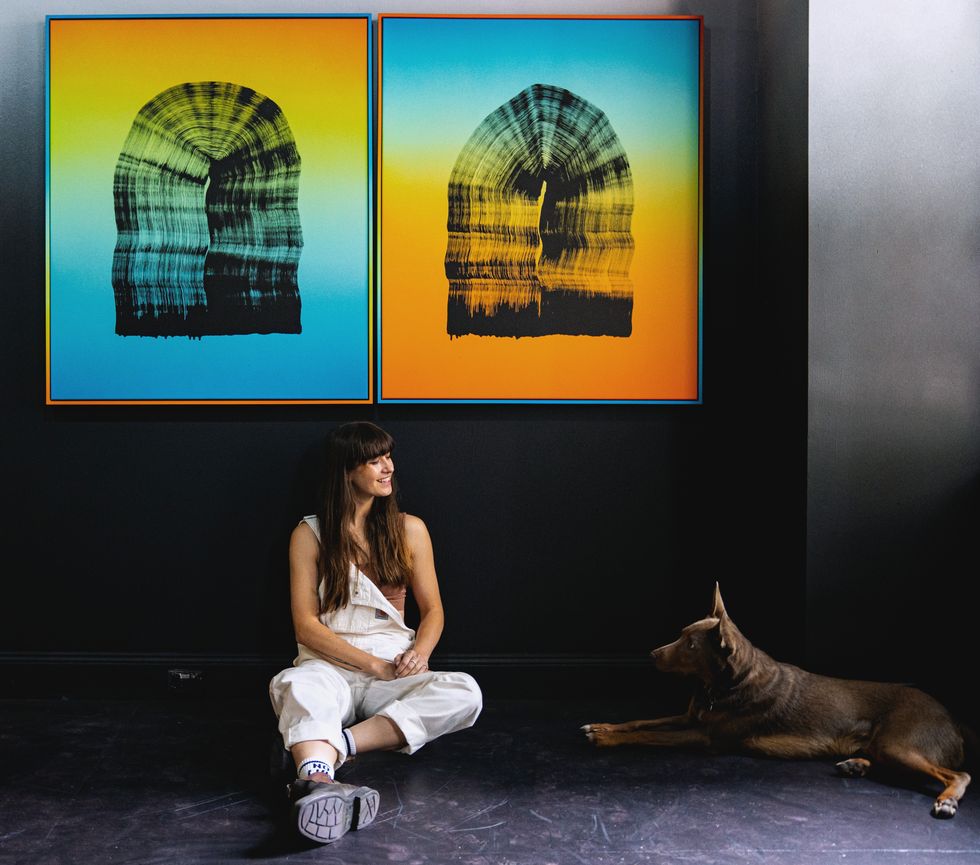
Courtesy of George Rose
How did your personal style evolve?
GR: “In the beginning, I did a lot more black and white until someone said, ‘You’re actually quite good with color.’ Then I just went full crazy with color. I love exploring color because it can create these bizarre optical illusions where there’s a lot of vibration between different colors. I love the push and pull. I’m interested in color theory, and I like to play with that on the wall. I used to experiment on smaller walls using spray cans, and then I started using the spray gun to get those bigger gradients and fades. I got rid of spray cans because they don’t last very well, and the sun eats away at the colors, so I started using house paint. At a certain point, I was like, ‘Oh, I do gradients and hard lines, and I have these textures in the background.’ It created almost a recipe for my work."
What are you excited to work on moving forward?
GR: “I actually pushed back on a fair bit of work, and I’m going into the studio for a bit. I’m really excited to do some canvas works for the next month or two. I’d love to do a residency and work on smaller canvases. Well, by small, I mean 1 meter by 1.5 meters.
“I love painting walls; it’s my favorite thing to do, but it’s hard on your body and life. The amount of things I’ve missed out on from not being in one place, the amount of friends I’ve lost touch with—it’s a strange existence. You don’t get to do these weekly activities like go to the pub or do trivia, or even just have a routine.”
Has this line of work made you see walls differently? Is there a Moby Dick dream wall that you’ve been chasing?
GR: “Ever since I started, there have been a few things I’ve wanted to paint. I’ve always wanted to paint an airplane, although they have weight restrictions, and paint actually adds weight to the plane. I’ve always always wanted to paint from a strop stage—they’re the ones that come down from a ceiling. I also want to do a skyscraper—something that’s 20 stories high but from a drop stage.
“There was definitely a time when it flipped, and I started to see walls and point them out to everyone like, ‘That’s a really nice wall.’ Even with my friends now, we look at walls, we’re like, ‘That would be a nice one to paint.’”
So that’s your inside baseball? Wall talk?
GR: “Oh yeah. It’s wall talk. It’s so normalized for us, but it must sound fucking crazy to people who don’t paint.”

Mike Chaney
Rapid Fire Questions
Hidden talent? “I have an inbuilt GPS in my brain, which is a pointless superpower these days. Also, I can predict the plots of movies and TV shows. It annoys my partner, and now I'm banned from speaking or sharing my theories during a movie.”
Irrational fear? “Spiders. It's totally irrational and not like a vague fear; I'd say it's more like a phobia. I actually quite like spiders and would go so far as to say I think some of them are cute, but I also kind of hyperventilate and ugly-cry if I have to walk under the web of an Orb Spider or I'm in a room with, say, a Huntsman. Which is sad because Huntsman spiders especially are kind of goofy and funny, but they fucking terrify me.”
Desert island picks? “Wifi and an unlimited subscription to audible plus pencils and paper?”
Something you used to hate but you love now? “Bananas.”
The best mistake you’ve made? “Not preventing my partner from getting a dog, now we have this beautiful little Kelpie called Sunny Boy. He's very sweet and takes up so much time but has been strangely worth it.”
In a biopic about your life, who would play you? “OMG, so hard. Initially, I thought maybe Dakota Johnston, but then I thought maybe Daisy Ridley. She's got that silly goofy energy and is strong and athletic, so she would probably do the role justice.”
What’s your biggest flex? “I know a lot about paint, and I get a lot of secret joy when going to the hardware store and slowly converse with the men behind the counter until they realize I know a lot more than they do. It's a kind of perverse satisfaction seeing their faces change when this realization hits them.”
Top 5 most-used emojis? 




The last movie, book, or song that made you cry? “I can't really recall a movie, book, or song that's made me cry, but the book Three Women was devastatingly heartbreaking!”
Who is your dream collaborator? “I would love to collaborate with one of the high fashion labels. Gucci, Prada, Burberry, etc. I love fabric yardage and painting and would love to collaborate on a runway show or something of that sort.”
Best piece of advice you’ve ever received? “Study art instead of science.”

